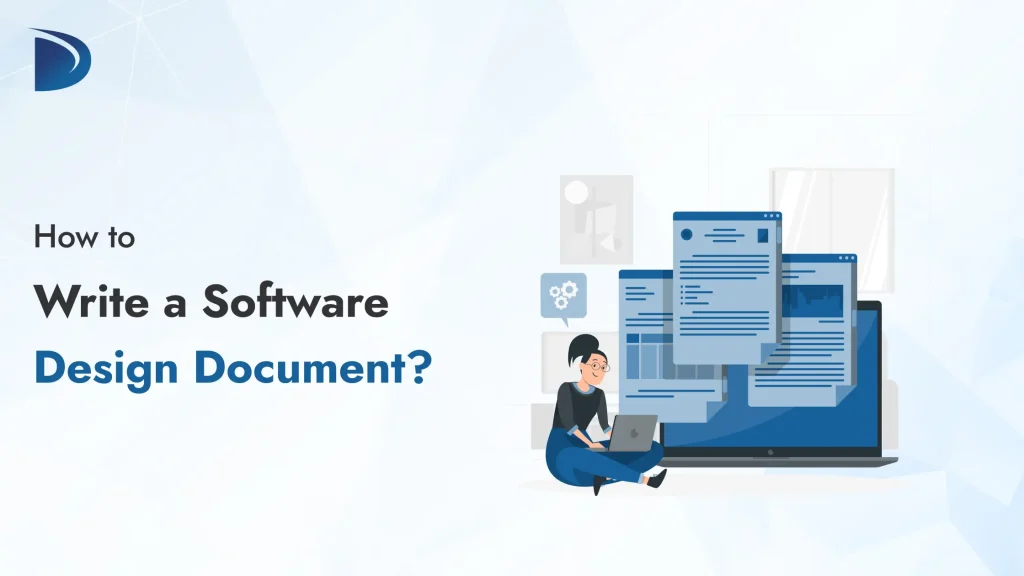Table of Contents
Creating a well-structured Software Design Document (SDD) is essential for guiding development teams to stay aligned and ensuring a smooth project workflow or success. In this guide, we have explained how to create an effective SDD, covering its purpose, essential components, best practices, and common mistakes to avoid.
What is a Software Design Document?
A Software Design Document (SDD), also known as a Software Design Description, is a detailed plan that describes how a software system will be developed. It acts as a blueprint, outlining the system’s architecture, components, interfaces, and data flow. The SDD ensures that everyone (developers, designers, and stakeholders) have a clear understanding of the system’s structure and effective communication among team members.
Purpose of a Software Design Document
A Software Design Documentation has several key purposes:
- Guiding Development: It provides developers with a clear plan, reducing confusion and making the coding process easier.
- Facilitating Communication: It acts as a shared reference point for discussions among developers, testers, and project managers to ensure everyone is on the same page.
- Ensuring Consistency: Helps maintain uniform coding standards, big decisions, and architectural approaches across the project.
- Supporting Maintenance: It serves as a valuable resource for future updates, bug fixes, and scaling efforts.
Key Components of a Software Design Document
An effective Software Design Document includes the following sections:
1. Introduction
- Purpose: Explain the goal of the document and who should read it.
- Scope: Define the boundaries, what the system will and won’t cover.
- Definitions & Acronyms: List any specific technical terms and their meanings used in the document.
2. System Overview
- Architecture Description: Provide a high-level overview of the system’s architecture, including diagrams showing how different parts are connected.
- Context Diagram: Show how the system interacts with users, other systems, or hardware components.
3. Design Considerations
- Assumptions & Dependencies: Mention any assumptions made during the design process and external dependencies that may impact the system.
- Constraints: Highlight limitations like performance targets, regulatory requirements , or hardware restrictions.
- Risks & Mitigations: Identify potential risks and propose strategies to mitigate/manage them.
4. Detailed System Design
- Module Descriptions: Explain each system module or component, including its purpose, functionality and how it works.
- Data Flow Diagrams: Show how data moves through the system highlighting inputs, processes, and outputs using simple visual representations.
- Interface Specifications: Describe how different modules interact with each other, including APIs, communication protocols and data formats.
- Data Structures: Outline the data models, including database design, key data types, and relationships.
5. User Interface Designs
- Screens & Layouts: Include mockups or wireframes of how the application will look.
- Navigation Flow: Explain how users will navigate through the application system.
- Usability Considerations: Ensure the design is user-friendly, responsive, and accessible.
6. Security Considerations
- Threat Model: Identify possible security risks and vulnerabilities.
- Security Measures: Outline protections like authentication, encryption, and other security controls.
7. Performance Considerations
- Performance Requirements: Define expectations for speed, efficiency, and reliability.
- Optimization Strategies: Suggest ways to improve performance, such as caching or load balancing.
8. Testing Strategy
- Test Plans: Describe how testing will be carried out, from unit tests to final acceptance testing.
- Test Cases: Provide examples of test scenarios and expected results.
9. Appendices
- References: List any external documents, standards, or resources referenced.
- Glossary: Define technical terms used in the document for clarity.
Best Practices for Writing a Software Design Document
To create a clear and useful SDD, follow these best practices:
- Keep It Simple and Clear: Use plain language and avoid technical jargon that isn’t necessary.
- Use Visuals: Add diagrams, charts, and tables to explain complex information more easily.
- Be Consistent: Stick to the same terminology, format, and level of detail throughout the document.
- Work with Your Team: Involve developers, designers, and stakeholders to gather feedback, validate decisions and ensure accuracy.
- Keep It Updated: Regularly review and update the document as per project requirements or designs change.
- Follow Industry Standards: Follow organisational or industry guidelines to ensure the document is complete and of high quality.
Common Mistakes to Avoid
Avoid these common mistakes when creating a Software Design Documentation:
- Vague Descriptions: If details are unclear and less, developers may misunderstand requirements, leading to inconsistent implementations.
- Too Much Detail: Overloading the document or say including too much unnecessary information can make it harder to read and understand the key points.
- Ignoring Non-Functional Requirements: Failing to consider security, performance, or scalability can result in a system that doesn’t meet with the user needs.
- Not Involving Stakeholders: If stakeholders aren’t included, the project can lead to misaligned objectives and requirements.
- Not Updating the Document: An outdated software design documentation can mislead developers and slow down the projects progress.
Conclusion
A Software Design Document (SDD) is the main part of building any software system. It acts like a blueprint, giving developers clear instructions, keeping stakeholders aligned, and ensuring the project goals.
By outlining the system’s architecture, components, different choices, and requirements, an SDD helps prevent confusion and risks of costly errors. It also improves teamwork, makes onboarding easier for new developers, and makes the software easier to maintain and update in the future.
Taking the time to create a well-structured SDD leads to smoother development, better software quality, and a higher chance of success. Whether you’re building a small app or a large enterprise system, a clear design documentation always keeps your team organized and your software scalable and efficient.

